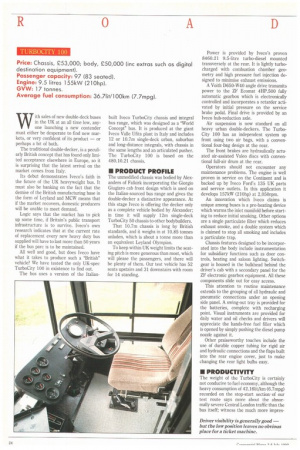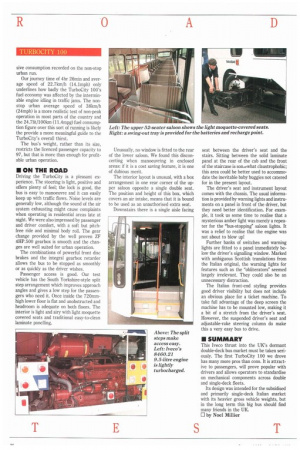Price: Chassis, 253,000; body, £50,000 (inc extras such as digital
Page 26

Page 28

If you've noticed an error in this article please click here to report it so we can fix it.
destination equipment).
Passenger capacity: 97 (83 seated).
Engine: 9.5 litres 155kW (210hp).
GVW: 17 tonnes.
Average fuel consumption: 36.71it/100km (7.7mpg).
With sales of new double-deck buses in the UK at an all time low, anyone launching a new contender must either be desperate to find new markets, or very confident of its product — or perhaps a bit of both.
The traditional double-decker, is a peculiarly British concept that has found only limited acceptance elsewhere in Europe, so it is surprising that the latest arrival on the market comes from Italy.
Its debut demonstrates Iveco's faith in the future of the UK heavyweight bus. It must also be banking on the fact that the demise of the British manufacturing base in the form of Leyland and MCW means that if the market recovers, domestic producers will be unable to meet demand.
Logic says that the market has to pick up some time, if Britain's public transport infrastructure is to survive. Iveco's own research indicates that at the current rate of replacement every new heavy duty bus supplied will have to last more than 50 years if the bus parc is to be maintained.
All well and good, but does Iveco have what it takes to produce such a "British" vehicle? We have tested the only UK-spec TurboCity 100 in existence to find out.
The bus uses a version of the Italian built Iveco TurboCity chassis and integral bus range, which was designed as a "World Concept" bus. It is produced at the giant Iveco Valle Ufita plant in Italy and includes 12 or 10.7m single-deck urban, suburban and long-distance integrals, with chassis in the same lengths and an articulated pusher. The TurboCity 100 is based on the 480.10.21 chassis.
• PRODUCT PROFILE
The unmodified chassis was bodied by Alexanders of Falkirk incorporating the Giorgio Giugiaro cab front design which is used on the Italian-sourced bus range and gives the double-decker a distinctive appearance. At this stage Iveco is offering the decker only as a complete vehicle bodied by Alexander; in time it will supply 12m single-deck TurboCity 50 chassis to other bodybuilders.
That 10.7m chassis is long by British standards, and it weighs in at 10.85 tonnes unladen, which is about a tonne more than an equivalent Leyland Olympian.
To keep within UK weight limits the seating pitch is more generous than most, which will please the passengers, and there will be plenty of them. Our test vehicle has 52 seats upstairs and 31 downstairs with room for 14 standing. Power is provided by Iveco's proven 8460.21 9.5-litre turbo-diesel mounted transversely at the rear. It is lightly turbocharged with combustion chamber geometry and high pressure fuel injection designed to minimise exhaust emissions, A Voith D650-W40 angle drive transmits power to the ZF Ecomat 41IP.500 fully automatic gearbox which is electronically controlled and incorporates a retarder activated by initial pressure on the service brake pedal. Final drive is provided by an Iveco hub-reduction axle.
Air suspension is now standard on all heavy urban double-deckers. The TurboCity 100 has an independent system up front using two air bags, with a conventional four-bag design at the rear.
The front brakes are hydraulically actuated air-assisted Valeo discs with conventional full-air drum at the rear.
Operators should not encounter any maintenance problems. The engine is well proven in service on the Continent and is backed up by Iveco Ford's 135 UK parts and service outlets. In this application it develops 157kW (210hp) at 2,050rpm.
An innovation which Iveco claims is unique among buses is a pre-heating device which warms the inlet manifold before starting to reduce initial smoking. Other options are a single particulate filter which reduces exhaust smoke, and a double system which is claimed to stop all smoking and includes a particulate trap.
Chassis features designed to be incorporated into the body include instrumentation for subsidiary functions such as door controls, heating and saloon lighting. Switchgear is housed in the bulkhead behind the driver's cab with a secondary panel for the ZF electronic gearbox equipment. All these components slide out for easy access.
This attention to routine maintenance extends to the grouping of all hydraulic and pneumatic connections under an opening side panel. A swing-out tray is provided for the batteries, complete with recharging point. Visual instruments are provided for daily water and oil checks and drivers will appreciate the hands-free fuel filler which is opened by simply pushing the diesel pump nozzle against it.
Other praiseworthy touches include the use of durable copper tubing for rigid air and hydraulic connections and the flaps built into the rear engine cover, just to make changing the rear light bulbs easy.
• PRODUCTIVITY
The weight of the TurboCity is certainly not conducive to fuel economy, although the heavy consumption of 42.16litiltm (6.7mpg) recorded on the stop-start section' of our test route says more about the abnormally severe Central London traffic than the bus itself; witness the much more impres sive consumption recorded on the non-stop urban run.
Our journey time of 4hr 26min and average speed of 22.7krn/h (14.1mph) only underlines how badly the TurboCity 100's fuel economy was affected by the interminable engine idling in traffic jams. The nonstop urban average speed of 38km/h (24mph) is a more realistic test of non-peak operation in most parts of the country and the 24,7lit/100km (11.4mpg) fuel consumption figure over this sort of running is likely the provide a more meaningful guide to the TurboCity's overall thirst.
The bus's weight, rather than its size, restricts the licenced passenger capacity to 97, but that is more than enough for profitable urban operation.
• ON THE ROAD
Driving the TurboCity is a pleasant experience. The steering is light, positive and offers plenty of feel; the lock is good, the bus is easy to manoeuvre and it can easily keep up with traffic flows. Noise levels are generally low, although the sound of the air system exhausting might cause complaints when operating in residential areas late at night. We were also impressed by passenger and driver comfort, with a soft but pitchfree ride and minimal body roll. The gear change provided by the well proven ZF 41{P.500 gearbox is smooth and the changes are well suited for urban operation.
The combinations of powerful front disc brakes and the integral gearbox retarder allows the bus to be stopped as smoothly or as quickly as the driver wishes.
Passenger access is good. Our test vehicle has the South Yorkshire-style split step arrangement which improves approach angles and gives a low step for the passengers who need it. Once inside the 720mmhigh lower floor is flat and unobstructed and headroom is adequate on both floors. The interior is light and airy with light moquette covered seats and traditional easy-to-clean laminate panelling. Unusually, no window is fitted to the rear of the lower saloon. We found this disconcerting when manoeuvring in enclosed areas: if it is a cost saving feature, it is one of dubious merit.
The interior layout is unusual, with a box arrangement in one rear corner of the upper saloon opposite a single double seat. The position and height of this box, which covers an air intake, means that it is bound to be used as an unauthorised extra seat.
Downstairs there is a single aisle facing seat between the driver's seat and the stairs. Sitting between the solid laminate panel at the rear of the cab and the front of the staircase is somewhat claustrophobic; this area could be better used to accommodate the inevitable baby buggies not catered for in the present layout.
The driver's seat and instrument layout comes with the chassis. The usual information is provided by warning lights and instruments on a panel in front of the driver, but they need better identification. For example, it took us some time to realise that a mysterious amber light was merely a repeater for the "bus-stopping" saloon lights. It was a relief to realise that the engine was not about to blow up!
Further banks of switches and warning lights are fitted to a panel immediately below the driver's signalling window. Marked with ambiguous Scottish translations from the Italian original, the warning lights for features such as the "obliterators" seemed largely irrelevant. They could also be an unnecessary distraction.
The Italian front-end styling provides good driver visibility but does not include an obvious place for a ticket machine. To take full advantage of the deep screen the machine has to be mounted low, making it a bit of a stretch from the driver's seat. However, the suspended driver's seat and adjustable-rake steering column do make this a very easy bus to drive.
• SUMMARY
This Iveco thrust into the UK's dormant double-deck bus market must be taken seriously. The first TurboCity 100 we drove has many more pros than cons. It is attractive to passengers, will prove popular with drivers and allows operators to standardise on mechanical components across double and single-deck fleets.
Its design was intended for the subsidised and primarily single-deck Italian market with its heavier gross vehicle weights, but in the long term this big bus should find many friends in the UK.
El by Noel Millier
















































































